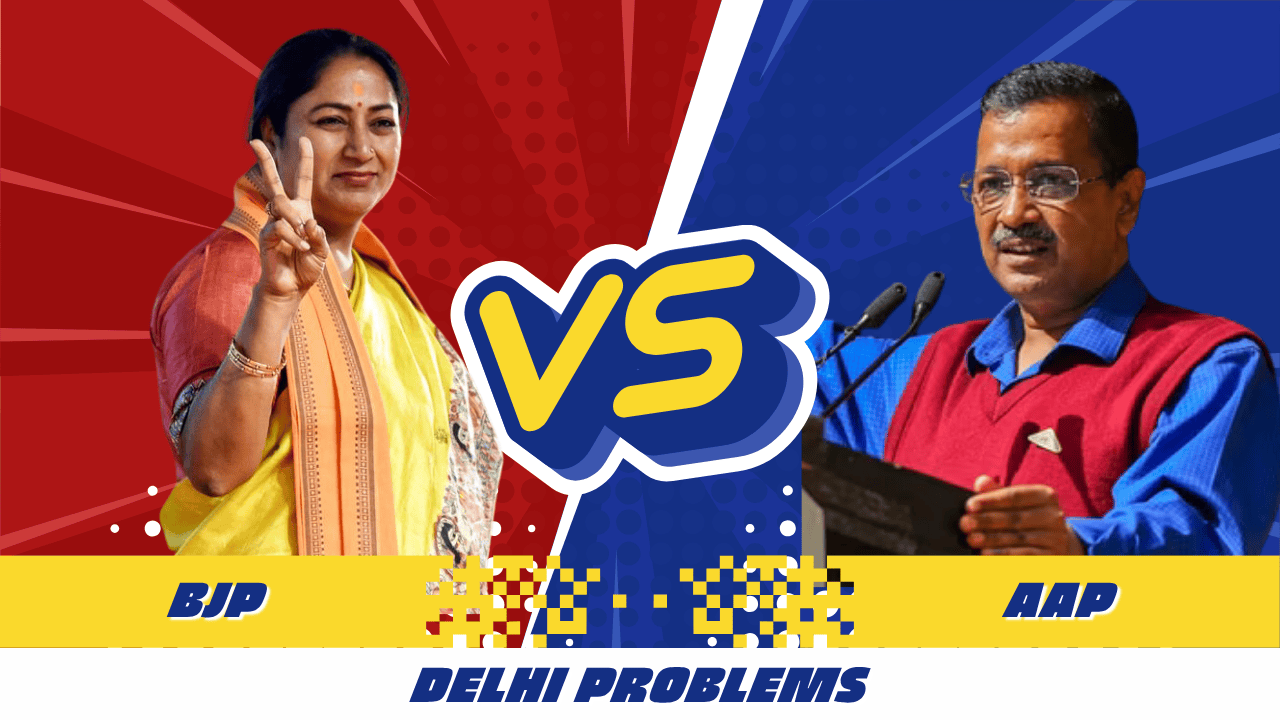Listen to This Article
BJP Government Failure Since Winning the Delhi Election: How Citizens Are Paying the Price
In recent years, Delhi has witnessed numerous challenges under the BJP-led administration. While political campaigns promised development, prosperity, and improved quality of life, the reality has often been starkly different. From persistent electricity cuts and chronic water shortages to controversial vehicle policies and questionable spending, Delhiites have been forced to grapple with issues that impact daily life and raise serious concerns about governance.
This article explores in detail the main failures of the BJP government in Delhi, shedding light on why many citizens feel let down despite repeated assurances of better days.
Electricity Cuts: The Dark Side of Governance
Unfulfilled Promises of Uninterrupted Power
One of the biggest promises made during the election campaigns was 24x7 electricity supply across all parts of Delhi. However, frequent power cuts remain a harsh reality, especially in densely populated areas and during peak summer months.
Residents in areas such as East Delhi, North Delhi, and several parts of South Delhi have reported power outages lasting 2–5 hours on multiple days each month. Small business owners, students, and working professionals who rely on electricity for their livelihoods have been the worst hit.
The government’s inability to modernize aging electrical infrastructure, address load management issues, and invest in sustainable energy solutions has only worsened the crisis. Instead of proactively tackling these challenges, authorities often resort to blame games between departments and agencies.
The Impact on Vulnerable Groups
Power cuts don’t just inconvenience people—they can be life-threatening. For elderly residents and patients who depend on electrical medical equipment, such as oxygen concentrators, prolonged outages can be dangerous. In the 21st century, this level of mismanagement is both alarming and unacceptable.
Water Problems: A Never-Ending Struggle
Water Shortages and Contamination
Despite tall claims about ensuring clean and sufficient water supply, Delhi continues to face severe water shortages, particularly in low-income and unauthorized colonies. Many households still rely on private tankers, paying exorbitant rates for something as basic as drinking water.
Additionally, contaminated tap water has emerged as another chronic problem. Studies and surveys by independent bodies have highlighted high levels of harmful bacteria and chemicals in the piped water supply, posing significant health risks.
Ineffective Water Management Policies
The BJP government’s failure to upgrade pipelines, invest in water treatment plants, and curb water theft has contributed to the crisis. Experts point out that Delhi loses almost 40% of its treated water to leakages and unauthorized connections. These inefficiencies not only waste precious resources but also strain the city’s already stretched finances.
 Unlock Your Savings Today!
Unlock Your Savings Today!
Get the best deals with unbeatable service and exclusive offers.

New Vehicle Policies: Hurting the Common Citizen
Policies That Ignore Real-World Needs
The government’s new vehicle policies, including stringent restrictions on older vehicles and sudden changes in road tax norms, have burdened middle-class families. For instance, the abrupt implementation of scrappage policies for vehicles over 15 years old has left thousands scrambling to replace their only means of transport.
While reducing pollution is important, policies must balance environmental priorities with affordability and practicality. Instead, these vehicle rules have disproportionately impacted those who cannot afford new vehicles or the extra costs of compliance.
Lack of Infrastructure to Support Policy Goals
Adding to the frustration is the absence of adequate infrastructure, such as convenient public transport alternatives and accessible charging stations for electric vehicles. In effect, policies designed on paper have been imposed on a city that lacks the capacity to absorb them, leading to widespread resentment.
Unnecessary Expenses: Artificial Rain During Monsoon
A Dubious Priority
One of the most controversial decisions has been the artificial rain project during the monsoon season, intended to combat air pollution. Experts have widely criticized this move, pointing out that monsoon naturally brings rainfall and that artificial intervention at such a time is redundant.
Estimates suggest that the project cost taxpayers tens of crores of rupees, with no measurable impact on pollution levels. For citizens already struggling with rising living costs, the use of public money on such experiments has been difficult to justify.
Other Unjustified Expenses
This isn’t an isolated incident. Over the last few years, spending on events, branding campaigns, and promotional activities has surged, while core issues like infrastructure repair and welfare schemes have languished. This raises an important question: Are taxpayer funds being spent where they are truly needed?
Rising Cost of Living Without Tangible Benefits
Inflation and Utilities
Despite promises of economic relief, Delhi’s cost of living has continued to climb. Utility bills have soared, and food prices remain high. Meanwhile, the government has been slow to roll out effective subsidies or support measures for those most affected.
Failure to Deliver on Affordable Housing
Affordable housing schemes that were expected to offer relief to lower-income families have also seen delays and implementation failures. Thousands of applicants continue to wait for possession or even allocation of promised units, often while paying high rents in overcrowded neighborhoods.
Governance Paralysis and Blame Games
Lack of Accountability
Perhaps the most frustrating aspect of the BJP government’s tenure has been the lack of accountability when things go wrong. Whether it’s power cuts, water crises, or policy blunders, officials frequently point fingers at other departments, agencies, or even opposition parties.
Instead of clear communication and transparent action plans, citizens are left with vague explanations and no real solutions.
Undermining Local Governance
Another major issue has been the consistent undermining of municipal bodies and local governance structures, which has further slowed problem-solving at the ground level. Experts argue that empowering local councils could have delivered faster relief to residents facing everyday problems.
The Road Ahead: What Needs to Change
If Delhi is to move forward and realize its potential as a world-class city, the government must urgently address these failures. Here are some steps that can pave the way for improvement:
-
Invest in Infrastructure: Upgrade aging power grids, water pipelines, and public transport to build resilience.
-
Focus on Transparency: Clearly communicate project objectives, costs, and timelines to build public trust.
-
Adopt Practical Policies: Balance environmental goals with economic realities to avoid unfairly burdening the middle class.
-
Strengthen Local Governance: Empower municipal bodies to make localized decisions more effectively.
-
Prioritize Essential Services: Allocate resources to critical areas like water supply, healthcare, and affordable housing rather than non-essential projects.
Conclusion
Delhi’s citizens deserve a government that delivers on its promises and prioritizes their well-being. The repeated failures of the BJP administration—from electricity cuts and water shortages to impractical vehicle policies and wasteful expenditures—underscore the urgent need for a new approach to governance.
As elections draw nearer, voters must carefully evaluate whether the current leadership has earned another term, or whether it’s time to demand accountability and change.
By holding leaders to their promises and insisting on transparency, Delhi can hope for a future where development is not just a campaign slogan but a lived reality.
 Grow Your Business with Proven Digital Marketing
Grow Your Business with Proven Digital Marketing
Ready to attract more customers and outshine your competition? Our tailored digital marketing strategies help you rank higher, generate qualified leads, and build a brand people trust. Let’s take your business to the next level.
Digital Marketing Solutions in Leading Cities

Work Differences Between BJP and the Previous Party (AAP)
1️⃣ Electricity Supply
-
AAP focused heavily on subsidizing electricity. They provided up to 200 units free per household and modernized some of the distribution infrastructure, reducing outage complaints over time.
-
BJP, after winning control over Delhi administration and municipal bodies, promised uninterrupted power, but complaints about frequent cuts, especially during summer, have increased. There has also been less visible investment in upgrading transformers and cables.
2️⃣ Water Supply
-
AAP extended water pipelines to unauthorized colonies and provided many households with up to 20,000 litres of free water each month.
-
Under the BJP, there have been persistent issues with shortages, leakages, and contaminated supply. New pipeline projects have seen delays, and tanker mafias continue to thrive.
3️⃣ Vehicle Policies
-
AAP introduced incentives for electric vehicles and improved last-mile connectivity through electric buses.
-
BJP implemented stricter vehicle scrappage policies without offering adequate financial support or infrastructure, which many felt hurt the middle class.
4️⃣ Pollution Control
-
AAP implemented large-scale measures like the Odd-Even scheme and greening drives.
-
BJP funded controversial initiatives such as artificial rain during the monsoon, which experts argued were ineffective and wasteful.
5️⃣ Spending Priorities
-
AAP was known for focusing spending on education, healthcare (Mohalla Clinics), and subsidies.
-
BJP has allocated significant funds to events, publicity campaigns, and experiments like artificial rain, with less emphasis on improving schools and hospitals.
6️⃣ Transparency & Accountability
-
AAP frequently conducted press conferences and town hall meetings to share updates on their progress.
-
BJP governance has seen frequent blame games between different departments and less transparent communication.
Summary Table: AAP vs. BJP Governance in Delhi
| Area | AAP Governance | BJP Governance |
|---|---|---|
| Electricity | Subsidized up to 200 units, improved supply reliability. | Frequent outages, limited infrastructure upgrades. |
| Water Supply | Free basic water, expanded pipelines in poor areas. | Continued shortages, leaks, and contamination issues. |
| Vehicle Policy | EV incentives, electric buses, phased rollouts. | Strict scrappage rules, limited support/infrastructure. |
| Pollution Control | Odd-Even scheme, greening projects. | Artificial rain projects criticized as ineffective. |
| Spending Priorities | Focus on education, health, and subsidies. | Spending on publicity, events, and questionable projects. |
| Transparency | Frequent updates, public engagement. | Less frequent communication, more blame-shifting. |
Conclusion
While AAP prioritized welfare subsidies, education, and healthcare, the BJP has focused more on regulatory changes, higher spending on experiments and publicity, and stricter enforcement policies. However, many citizens feel that essential services like power, water, and pollution control have deteriorated rather than improved under the BJP’s leadership.
Disclaimer:
The views expressed in this article are for informational purposes only and are based on publicly available data, media reports, and independent analyses. This blog does not intend to defame, discredit, or promote any political party, organization, or individual. Readers are encouraged to verify facts independently and form their own opinions. The author and publisher are not liable for any decisions made based on the content of this post.

 Disclaimer
Disclaimer
The views expressed by experts in this article are their own and do not necessarily reflect the opinions of any website, organization, institution, or affiliated entity. If you have any concerns regarding this article, please contact us at contact@quantamminds.com and also on WhatsApp
Frequently Asked Questions
Why are there still electricity cuts in Delhi despite the BJP government’s promise of 24x7 power supply?
The BJP government assured uninterrupted electricity, but infrastructure upgrades have lagged behind demand. Aging transformers, overloaded grids, and lack of investment in modern systems have led to frequent outages, especially during peak summer months. Many residents report that the situation has worsened in several areas compared to previous years.
What was the purpose of artificial rain during the monsoon, and why has it been criticized?
Artificial rain was intended to reduce pollution levels in Delhi. However, implementing it during the monsoon season made it redundant since natural rainfall was already expected. Environmental experts criticized the project as a waste of taxpayer money, with no measurable improvement in air quality.
How have new vehicle policies under BJP governance affected ordinary citizens?
The BJP introduced strict vehicle scrappage policies requiring older vehicles over 15 years old to be retired, often with little notice. While reducing emissions is important, many middle-class families could not afford to replace their vehicles quickly. The lack of adequate public transport alternatives and financial support has made compliance challenging for many.
What are the main differences in water management between the previous government and the BJP?
The previous government (AAP) prioritized expanding pipelines into underserved colonies and providing free basic water. Under the BJP, problems with water shortages, leaky pipes, and contamination have persisted. Many residents still rely on expensive water tankers, and little progress has been made in curbing waste or theft.
Has the cost of living increased under the BJP government in Delhi?
Yes, the cost of living has continued to rise. Electricity bills, fuel prices, and household expenses have all gone up, while essential services have seen minimal improvement. Critics argue that increased spending on events and experiments has diverted resources from more impactful relief measures for citizens








 Ashwani Kumar on 2025-07-04
Ashwani Kumar on 2025-07-04





